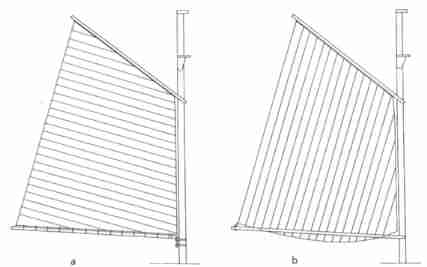Overview of the Gaff Rig
Revised 06/30/00
|
Overview of the Gaff Rig Revised 06/30/00 |
|
|
|
|
|
|
When I first saw the gaff rig, I was excited about the "new" sail. While an indication of just how ignorant I am about sailing, it also speaks to the beauty of the rig to the uninitiated.
The sail
is striking in its difference,
a trapazoid rather than a tall and thin triangle, the gaff sail has a feeling
of old-world character. You'll never be reminded of hypontenuses
again. Here, from John Leather's The Gaff Rig Handbook, are
the two basic main sails seen on gaff rigs. The shorter side of the
sail, along the mast, is the luff, and working counter-clockwise,
we find the head at the top, the leech along the longer
side and then the foot at the bottom. "A" has the sail
laced to the boom, while "B" is loose-footed. The sail is
supported at the head by the gaff (with lacing), and is laced
to the boom along its length as in "A", or has its clew, the lower
left corner of the sail in these illustrations, attached to the end of
the boom as in "B."

The rest of the Detail Pages continue to show details on the elements of the gaff rig. For the purposes of this overview, I will mention the running rigging for the main sail only. More details are available on the pages devoted to each of these topics.
The halyards, or "ropes" that control raising and lowering the sail, are the peak halyard and the throat halyard. The peak halyard is attached to the gaff, toward the end away from the mast, and is used to adjust the angle of the gaff upward to trim the sail. The throat halyard attaches to the gaff near the jaws, and raises that portion of the gaff until the luff is straight.
The main sheet, or rope that allows the
sailor to swing the boom from side to side to adjust to the wind, is much
like the main sheet on a bermudian or marconi rig. The detail pages
will show some provisions to finely tune the gaff sail.
This page is currently under construction. I'm still gathering
information on the gaff rig, and would appreciate hearing about
any other resources.
More to come!

|
|
|
|
|
|